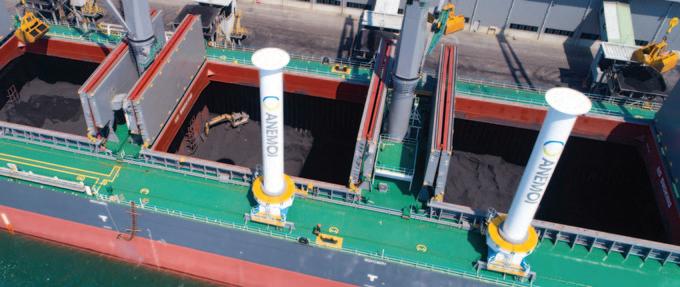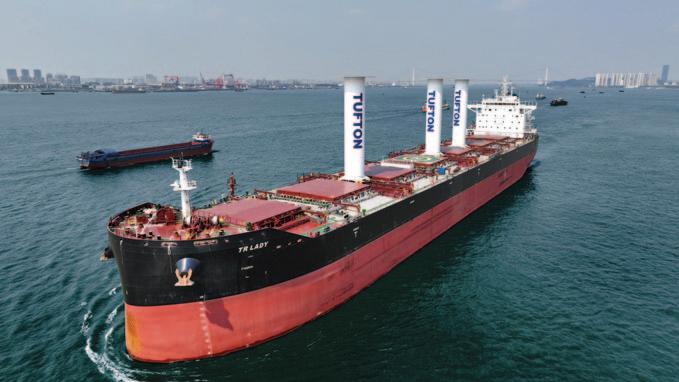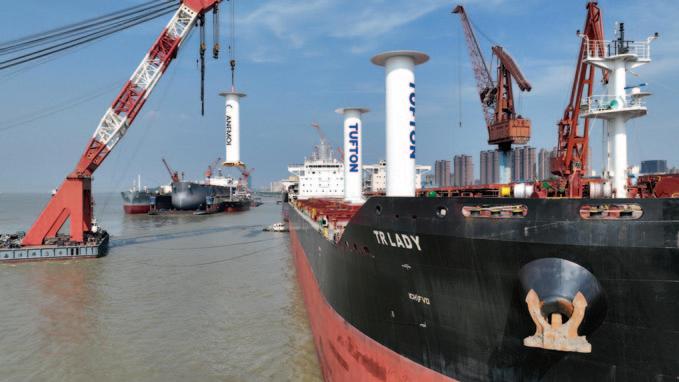
5 minute read
Rotor Sails on course for improved bulker efficiency
In June, the 82,000dwt Kamsarmax bulk carrier TR Lady was retrofitted with three 24m-tall Rotor Sails from Anemoi Marine Technologies at Chengxi Shipyard in China. These mechanical cylinders were installed with the sole purpose of improving the energy efficiency of the vessel by providing alternative wind propulsion to reduce its fuel consumption and carbon emissions.
The results of the vessel’s maiden voyage following the installation showcased the true effectiveness of Rotor Sails for modern bulker vessels. Initial data from the vessel’s voyage from China to Australia indicated that the vessel can expect to save around 10% of fuel and emissions annually as a direct result of the newly installed technology.
Owners and managers of bulk carriers are in the midst of improving or bolstering the energy efficiency of the vessels. This issue continues to be a major talking point amongst major players, most recently following the 80th meeting of the International Maritime Organization’s (IMO’s) Marine Environmental Protection Committee (MEPC) in July, which reinforced the need for vessel owners to strengthen the energy efficiency of their vessel in line with global requirements. This includes the Carbon Intensity Indicator (CII), Energy Efficiency Existing ship Index (EEXI) and the Energy Efficiency Design Index (EEDI).
Fortunately, technologies, fuels and energy sources that reduce vessel emissions are becoming more readily available. With the recent success of the TR Lady voyage, it stands to reason that Rotor Sails are a leading option for bulker owners that are seeking viable, costeffective and commercially available decarbonization technologies that can be installed swiftly and provide a long-term return on investment.
Benefit For Bulkers
According to Morten Løvstad, DNV Maritime’s vice-president and global business director for bulk carriers, more than 60% of the global bulk carrier fleet will require measures to improve their CII rating if they are to remain compliant and competitive through to 2030.
Bulkers are ideally suited to rotor sail technology. Their large, open deck space allows for multiple Rotor Sails to be fitted in a configuration that can take advantage of plentiful wind supplies and maximize savings. Crucially, modern rotor sail technology can be installed with different deployment systems that can take advantage of a bulkers deckspace and alleviate concerns over loading and unloading operations.
While Rotor Sails are, as standard, fixed to the deck of a vessel, Anemoi supplies two other bespoke deployment options that are ideal for bulk carriers: folding and rail mounted. The folding deployment system lowers the Rotor Sails from vertical using hydraulics, making them ideal for vessels operating on routes with air draught restrictions and enabling them to the repositioned to ensure cargo operations are not impacted. Anemoi’s patented rail-mounted system allows the Rotor Sails to be moved along or across the deck of the ship when in port to again avoid impacting cargo loading and unloading operations.
This latter option was installed on the 64,000dwt Ultramax bulk carrier Afros in 2018. The vessel’s limited deckspace required an innovative approach to rotor sail placement and Anemoi’s rail-mounted system offered the flexibility to ensure the vessel could still operate effectively while taking advantage of the vast amount of renewable wind energy available during the vessel’s voyages.
Installation simplicity also remains one of rotor sail’s key advantages. They do not require any wholesale changes to the vessel’s structure or drydocking, making them ideal for retrofitting. Each rotor sail can be installed in a single crane lift and connected to the foundation on the ship’s deck. In the case of Afros, the installation of all the equipment took less than two hours per unit.
Growing Interest
“With shipowners and managers looking to minimize their carbon emissions while maintaining full operations, Rotor Sails have picked up steam in recent years as a way to provide auxiliary propulsion and reduce fuel consumption,” said Kim Diederichsen, CEO at Anemoi.
“The recent installation of Rotor Sails on TR Lady and the results we have seen so far show how effective Rotor Sails are when it comes to reducing the fuel consumption and emissions of a vessel. Rotor Sails are a visible, viable and costeffective decarbonization technology, not just for bulkers but for all types of vessels.”
The market for rotor sail technology continues to grow as ship owners and managers increase their efforts to meet the IMO’s GHG targets. According to the International Windship Association, more than 100 wind-assisted ships will be in operation by 2025, although wind propulsion stands to play a major role for vessels far beyond that, owing to the abundance of renewable wind power, the industry’s continued push for decarbonization, and the ability to combine wind propulsion with other energy saving devices and fuels.
Anemoi currently has 13 Rotor Sails in production and, due to growing interest, the company is ramping up its capacity to be able to install 50 Rotor Sails annually by the end of 2023. In November 2022, Anemoi reached an agreement with COSCO Shipping Heavy Industry (CHI), one of China’s leading shipbuilding organizations, to offer turnkey installations of Anemoi Rotor Sails. CHI has numerous yards capable of up to 7.5 million dwt annual production across all major vessel segments, making it an ideal yard partner for the uptake of this technology.
With more eco-friendly innovations in development, Rotor Sails have found their place in the industry as a credible decarbonization technology and offering ship owners a viable option to make an immediate impact on their fuel consumption and emissions. Anemoi has made its mark on the sector with a catalogue of successful installation projects on a number of bulk carriers and are putting the motions in place to ensure ship owners have access to a viable, cost-effective and long-term decarbonization technology.
Installation of Rotor Sails on TR Lady, an 82,000dwt Kamsarmax bulk carrier, was completed in Chengxi Shipyard, China, in June 2023. TR Lady is owned by TR Lady Shipping Ltd, a portfolio company of Tufton Investment Management Ltd (Tufton) and is on a time charter with Cargill.


The vessel was retrofitted with three 5×24m Rotor Sails by leading windpropulsion provider Anemoi Marine Technologies Ltd (Anemoi). The technology was installed on Anemoi’s unique and patented transverse rail deployment system. This system enables the sails, which are fixed to the centre line during voyages, to be moved port or starboard when berthed for cargo operations, meaning loading and unloading can continue without being obstructed. Class approvals have been awarded by Lloyd’s Register.
Rotor Sails, also known as ‘Flettner Rotors’, are vertical cylinders which, when driven to rotate, harness the renewable power of the wind to provide additional forward thrust.

These highly efficient mechanical sails capitalize on the aerodynamic phenomenon known as the Magnus Effect and will deliver significant fuel and emission savings to TR Lady.
The vessel has now completed its first voyage with the Rotor Sails from China to Australia. During this voyage, Anemoi engineers sailed with the vessel for sea acceptance testing and trials, with positive initial performance results which suggest that TR Lady can see average annual fuel and emissions savings exceeding the original expectations. The performance of the Rotor Sails will continue to be monitored over the coming months.
Of the installation, Andrew Hampson, CEO of Tufton, said, “We and our investors are committed to shipping’s decarbonization journey and believe wind propulsion is a key enabler in helping Tufton reach its 2050 net-zero goals. We are very proud to have been able to support this innovative application of decarbonization technology on TR Lady.”
Jan Dieleman, President of Cargill’s Ocean Transportation business, said, “We are pleased to be partnering with Tufton who share our decarbonization ambition and belief in wind propulsion as a key part of the future of shipping.”
Kim Diederichsen, CEO of Anemoi Marine Technologies, commented, “I am delighted to see the project brought to life and for the initial performance results to be so positive. The installation is a testament to our large supply chain in China and our dedicated team. We look forward to assessing the performance and seeing continued positive results for our environment.”
TR Lady retrofit project has been nominated for the ‘Retrofit Project of the Year’ award at the Annual Marine Propulsion Decarbonization Awards 2023.

